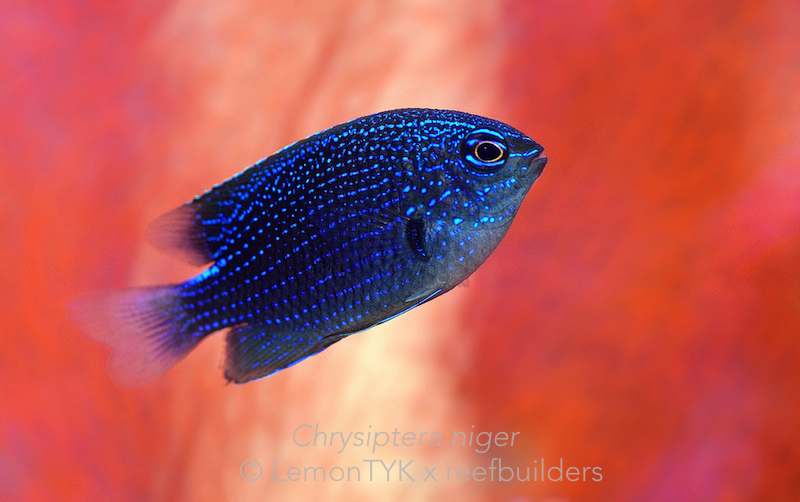Aquarama is a fish and accessories exhibition held biennially in Singapore, where exhibitors, exporters, industry authorities and hobbyists gather for a glimpse of the aquarium happenings in South-East Asia. Although Aquarama is mostly geared towards freshwater fish and their corresponding ribbon ponies, it offers a healthy dosage of marine related paraphernalia, such as the market debut of new fangled gadgets and equipment. More importantly, it’s also an excuse for the various industry personalities to gather and discuss on the latest happenings and gossip (kidding).

While the event floor is largely plagued with booths featuring gewgaws and other thingamabobs, rare fish of both realms are usually not in short supply. Exhibitors and exporters take the chance to show off unusual species of fish, because why not? We were definitely impressed with some of the more uncommon aquarium offerings, but one fish that really stood out was Chrysiptera niger, also known as the Tufi Damselfish.
C. niger is a small species endemic to Papua New Guinea (PNG) and the nearby D’Entrecasteaux Islands. C. niger has a ground coloration of inky cobalt, superimposed with a constellation of metallic azure dots arranged in a dot-dash pattern of horizontal stripes. The cheek and face is reticulated in a more kaleidoscopic and haphazard pattern of the same dots, and a more complete stripe runs along the dorsum. The top portion of the caudal peduncle is marked prominently.

The Tufi Damselfish got its name from Tufi Inlet, Papua New Guinea, where it was first known some forty years ago. Although the fish is not new to science, it is relatively rare in the aquarium hobby, making a brief appearance a couple of years ago before disappearing again altogether. So it would come as a surprise that while walking the halls of Aquarama, we spotted not one, but three Tufi Damsels perusing a small aquarium.
The damsels were on display in a booth shared by the PNG National Fisheries Authority and Paradise Aquariums. We sat down for a little bit and talked about some of the potentially exciting fishes from the region that would pique the interest of reef fish connoisseurs. Aside from Chrysiptera niger, Cirrhilabrus walindi is another species that i’ve been personally dying to see since forever ago. Paradise Aquariums is not exporting at the moment, but they will be soon, and hopefully we’ll get to see something promising in the near future.

Also on display in the same booth were a group of Halichoeres wrasses that did not seem familiar at first glance. A quick consult with Kuiter’s wrasse bible on hand (you mean you don’t carry it around casually?) revealed its identity as Halichoeres argus. H. argus is a beautiful labrid with a dizzying series of miniature green checkerboards superimposed on a reddish background. The face is a labyrinth of larger spots and streaks, and the fish most closely resembles H. melanurus and H. chrysotaenia. It can be differentiated from the latter two by having a more spotted anal fin tail respectively.

Despite its large range and preference for shallow waters, H. argus is actually pretty seldom encountered in the trade. It loses shine to its more popular and celebrated sister H. melanurus, but for reasons unjust and unclear. This species is no way any less spectacular. Paradise Aquariums and PNG’s National Fisheries Authority featured a group of mixed sexes in a single tank and they are just beaming with perfection.

Papua New Guinea is perhaps most well known for the harbouring of Morse Code Maroon clowns, a phenotype apparently restricted to this region, and most recently, the Solomon Islands. We’re not sure what’s going on around there, but oddly patterned Premnas with the occasional spot and stripe are not uncommonly collected. Extreme aberrations like the ramifying white net of the lightning Maroon Clownfish have also originated from PNG. Perhaps these clownfish reside in anemones adhering to rich veins of radioactive uranium. Perhaps not. Most definitely not.

Paradise Aquariums also displayed with the Tufi Damsels, a pair of these signature icons of PNG. With a nice collection of fishes on display even without exporting anything yet, it’s safe to say that we’ll be seeing more of Paradise Aquariums soon. Hopefully a more stable and regular influx of PNG fishes will grace the aquarium scene once again. We’ll be on a look out for sure! A big thanks to Lorel Oli and everyone else at the booth who took the time to entertain and talk to us.




